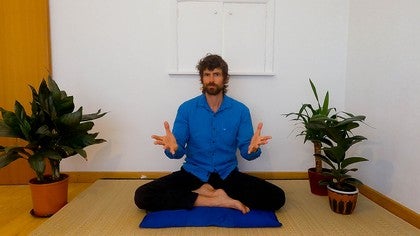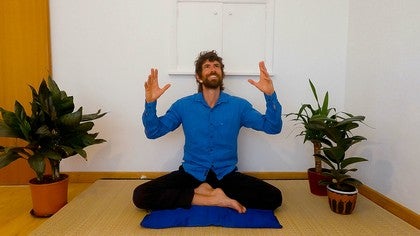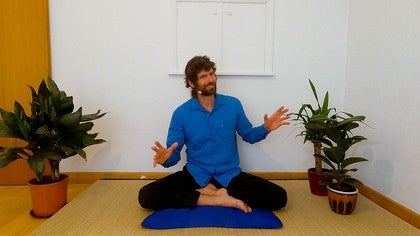Description
About This Video
Transcript
Read Full Transcript
Sutra 36 Satya Pratishdayam, Kriya Pala Shrietaam, So we're noticing here. This is the 2nd sutra. We've got this word. We had it previously, Hinsa, British Diane. We've got I am. So what does this word mean? It means that there is establishment.
But one of the connotations of this word, interestingly, is it's like it's a resting place. It's a place where one can be calm. It's a place of steadiness So again, in the language of the Sutra, it's encoding that as we become more established in these principles, we will become more robust, we will become more resilient, we'll become steadier, we'll become more peaceful, we will be able to rest more easily at the end of the day. And even in the midst of challenging situations, we'll have more more ease of access to a state of serenity. So following on from establishment in Ahinsa, bringing that state in which hostility ceases in our presence, potentially now says such a British dayum, Kriar Pala Shreatvams. We have Kriya, which means action, pala, the fruit or outcome of the action.
And they say he says they become, which means they're basically contiguous, their codependence. In other words, our the successful fructification of our actions happens unimpeded when we are established in Satya. So Satya is from the verb root us, which is the verb to be, often gets translated as truthfulness, but If we look at the verb root, it's also got this sense of presence of being, so Satya beingness. So telling the truth, being truthful, being honest is a big part of Satya. Another way we can think of such is when one is in a state of true with a capital t, authenticity, and presence.
The classic example or one of the classic examples for satyin in the yoga tradition is sitan in the Romina epic, and there are other similar episodes like this. But Sitan, is known to be established in Satya. What does this mean? Not just that she does not tell lies. That's part of it.
But more than that, she is always true to her to her soul, you might say. So it's very, very beautiful the way this is represented in Naramaaina. For a period, Sita is kidnapped and she is then separated from Rama, her beloved. But at a certain level, if we read the story symbolically, we can consider that Rahma symbolizes the soul and Sita symbolizes that pure lens clear insight and awareness and intellect. And all the while that Sita is separate from Raman, What her awareness remains oriented towards Rama, with every beat of her heart, she is tuning in to that energy, that presence of her beloved, and that is her deepest longing.
That is who she really is. When we transpose that symbolism onto our own lives, It's the idea that Rama is our soul, and Sita is our individual capacity to recognize that. When Sita is kidnapped, she gets kidnapped by a raven and who can be seen to represent the mind ego complex and all our habits. So what sometimes happens is that our way of being gets hijacked, kidnapped, overtaken, dominated by our conditioned ideas, by the habitual empatternings of our mind ego complex. And then it's like, oh, the true capacities the authentic capacities of our individual awareness.
It's like they are confined They are sequestered within the bounds within the confines that the mind ego complex has allowed itself to become accustomed to. But if through the practice of yoga, we can step step by step into greater authenticity, then these very lenses of our awareness with which we have habitually experienced all the myriad wonder of the divide of the diverse world, these very lenses will allow us to recognize to relish to savor and experience the depth, the true depth of our soul essence. And we could say that's the deepest authenticity. When our thought, word, and deed are all incongruents, with our souls longing, with the pilot light of our punishments. And this I would suggest is true authority.
There's a passage in the new testament of the Bible in the gospels where it says when the people were all amazed when Jesus spoke to them because he didn't teach like the other teachers. He didn't just cite the text. He spoke with authority. He spoke from a place of authentic understanding because he was speaking from his own experiential understanding. And this is very much an idea that we find in the Boag tradition as well to know in the yoga tradition is not to know what's something that some information that I have read.
Some knowledge that I can repeat, but to actually know it at the cell deep level, And so I would suggest that to become established in Satya means that our thoughts, our words, and our deeds have become the authentic impression, our deepest longings. When that is the case, it's like we have brought ourselves into rhythm and attunement with the pulsation of the cosmos. We've brought ourselves into harmony with the music of the spheres. And so when we seek to do something, we are acting in a way that is supporting that greater cosmic harmony. And so it's as if the forces of nature happily collude with us, and this brings this successful Fructification of our intended actions. In the Rama, you know, when Sita so I mentioned earlier, she's this classic example of a person who's established in the Satya.
There's this beautiful episode It's in the Sundarakanda. You can watch me telling this section of Ra Minor on the mythology show here on yoga anytime in the Ra minor section on Hanuman. Check it out if you haven't done already. I would invite you. But there's this episode where Hanuman, he's been searching for sit down.
He's an emissary of Raman. He's found seat done. And there's a fantastic story, but he gets his tail set on fire. And Sita, who is established in Satya, says, may he feel no heat? And Hanuman's there.
He's allowed his tail to be wrapped in, petrol dosed, oil dosed, fabric. His tails are blazing, and he looks back at things. Why does my tail feel so cool? And then he realized because Sita has, asked but he not feel this heat. And so she's this example of when one is that established in Satya.
What one says comes to pass. So when a person is established in Satya, what they say comes to pass. They become very, very reliable, and their actions bring the intended outcomes. Now, what does that mean for us here now? This is a prescription as well as a description.
So we might not quite be like Sita. I might find, well, maybe I am managing to be more authentically all of myself than I used to be. But as I have made the effort to practice that, I've also recognized that I'm still harboring these tendencies that cloud my awareness. Sometimes the force of my old, empatent habits can still get in the way of me really honestly. Fully in an embodied way expressing my deepest longings.
So what to do about it? How to practice Satya. So one thing that can be really helpful is to practice doing what I say I will do. The more a person becomes established in the society, the more dependable that person is. So when I say I will do something, do it. This is a fantastic thing to practice.
Being impeccable with our word as it were. And then another way we can press this very simply sometimes, you know, people talk about aspects of mindfulness practice, whatever I'm doing to be aware of it. And so as I'm telling myself, yes, Okay. Now, I'm gonna be doing this. I'm doing this. And I'm inviting myself to be focused, to be congruent, and coherent in what I am doing. And with practice, it's the idea that we can really cultivate and attune to the rich sensation of fuller presence that comes when thought word, indeed, are all aligned. And as I practice that, I might notice more readily when my thoughts are straying into areas that pull me away from efficiency and what I really seek to say or communicate or do.
So, Satya, we can think about it. I can cultivate congruence or integrity and authenticity. Now authenticity, I'm gonna there's a link to an article I've written about authority and authenticity, but Boag asks us to be the author of our own life. In the bhagavad Gita, Krishna is very, very clear. Your experience is your responsibility and your freedom your emancipation is your responsibility.
We may be blessed to meet great teachers to have great companions on the path. But ultimately, we have to work it ourselves. So we have to be the author of our own life. So another aspect of practicing Satya is to really examine, are my thoughts genuinely authentically my own, or have I allowed some of my viewpoints on my thoughts, on my habits, to actually have been unduly influenced by external ideas that I've allowed myself to get adhered to somehow. So, again, this practice of inquiry of examining where am I acting from? Why am I doing what I'm doing?
Is this my authentic deep longing? Is this perspective really my own, or am I just allowing myself to adopt it or hold it or carry it for convenience's sake? A short term convenience, which is actually not serving me in the long term, but not already in the short term because it's actually perpetuated a certain incongruence at the level of my soul. So my thought, my word, and my deed are they all really in tune with my deep belonging? So making this inquiry and taking practical, steady, small incremental steps to make that more and more cohesive. This is a way that we can cultivate Satya in our day to day as well, of course, of trying to be honest with ourselves, as well as with everybody else.
Now sometimes when we start practicing honesty, we might notice I've actually been deceiving myself about certain tendencies I have or certain patterns I have. And as we notice that, it can be a little bit unsettling. And so this is the irony in such a pretty the practice can bring us into an unsettled space. But as we navigate that patiently steadily, We bring forth more of our innate capacity to actually harmonize and find greater resolve, greater steadiness, even in the raging waters even in the whirlwind of life.
Yoga Sutras of Patanjali: Yamas and Niyamas
Comments
You need to be a subscriber to post a comment.
Please Log In or Create an Account to start your free trial.











